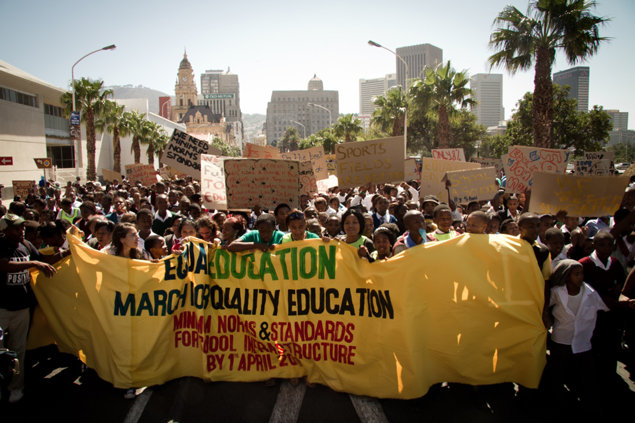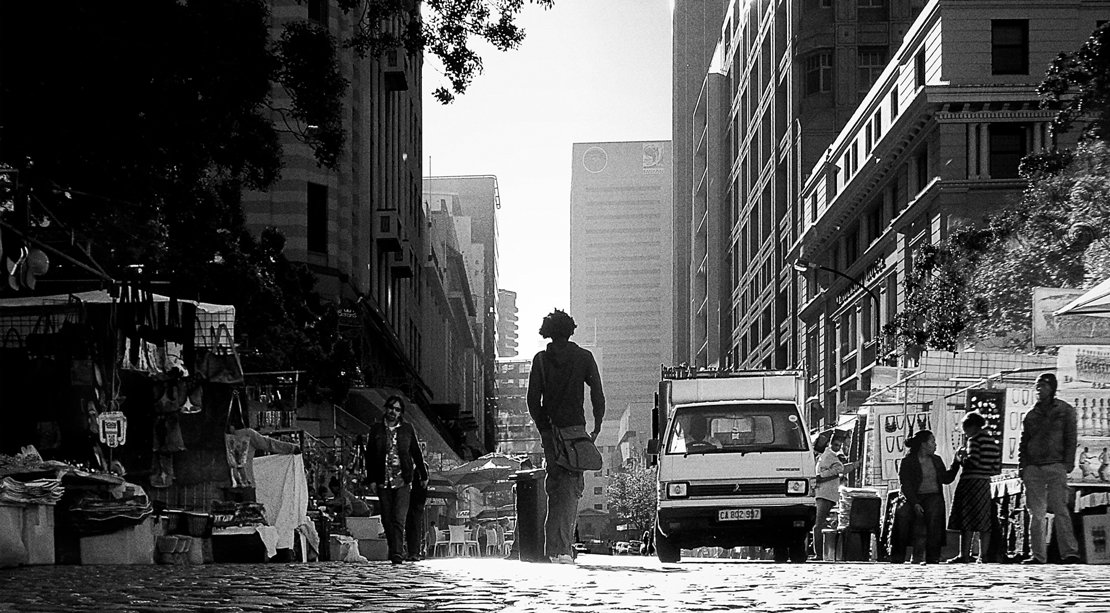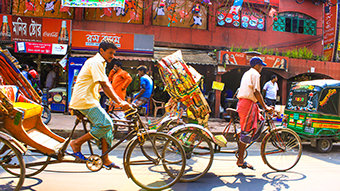Recent mob violence against immigrants to South Africa is regrettable, tragic and without a simple explanation. Despite media assertions that the attacks are xenophobic, a deeper look reveals that the raging tension is rooted deeper, in the nation’s crippling unemployment—a problem post-apartheid governments have abjectly failed to address.
As his mother tells it, 14-year-old Siphiwe Mahori had gone to a “spaza shop,” a makeshift convenience store, in the rundown Soweto district of Johannesburg, to buy a soft drink. But her son wound up laying on the ground in a pool of blood—evidently shot to death by the storeowner, an immigrant from Somalia who told police the boy was part of a group of people who had tried to rob his shop.
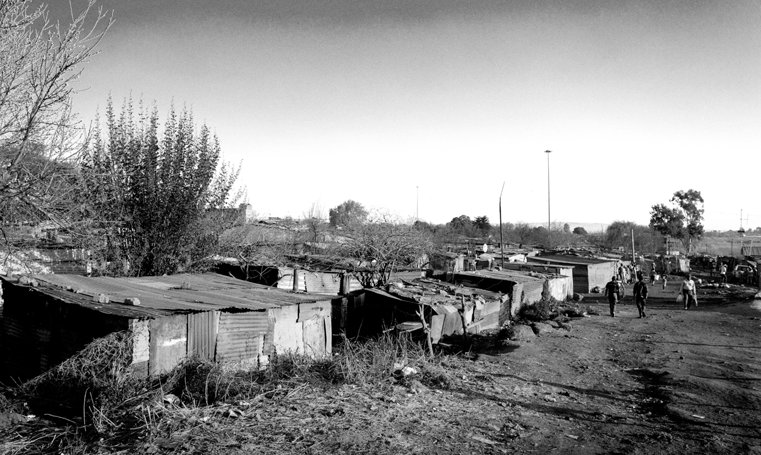
That January 19 incident triggered weeks of mob violence against immigrants from neighboring African countries and from Asia, who have a long history of setting up small businesses in South Africa’s affluent cities and towns. The violence, which swept through several South African cities, claimed the lives of seven immigrants and left scores injured. Thousands fled their homes or left the country in its wake.
Rejecting media assertions that xenophobia was the primary factor behind the attacks, South African President Jacob Zuma appointed a committee of 14 government ministers to investigate “the underlying causes of the violence and tensions.” The attacks, he emphasized, were “the legacy of poverty, unemployment and inequality.”
South Africans are frequently reminded of those challenges. And Zuma pithily summed up their origins in an April 27 Freedom Day speech marking the 21st anniversary of South Africa’s first multiracial general elections, which led to the historic inauguration of Nelson Mandela as the nation’s first black president. The anti-immigrant fury, Zuma said, is rooted in “years of apartheid dehumanization.”
The president was referring to the nearly 50 years of racial discrimination and repression native South Africans suffered under white-minority rule until 1994. And while that ghastly past undoubtedly played a role in the violence, Zuma appeared to be ducking responsibility for what critics say is his government’s abject failure to address the nation’s deep socioeconomic disparities.
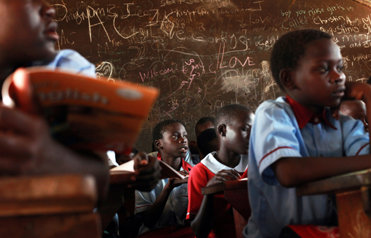
South Africa is one of the world’s most unequal societies. According to the World Bank, in 2011 the richest 20 percent of South Africa’s 45 million people held 70 percent of the national income, compared with 2.5 percent for the poorest 20 percent of the population. In the U.S., by contrast, the richest 20 percent of the population holds 46 percent of national income; the lowest 20 percent accounts for slightly less than 5 percent.
Most analysts agree that South Africa has considerable economic potential and that the nation has done much to redress the grievances of apartheid, not just by giving native blacks the right to vote in elections, but by including them for the first time in a range of government distribution policies aimed at improving their standard of living.
As Ángel Gurría, secretary-general of the Organization for Economic Cooperation and Development (OECD), put it in a speech during the launch of the 2013 Economic Survey of South Africa: “Per capita income is rising, access to public services is improving, social conditions are strengthening and crime rates are falling.”
And yet, said Gurría, citing South Africa’s own National Development Plan, “there is a burning need for faster progress, more action and better implementation” because “unemployment remains stubbornly high, and the distribution of income continues to be very skewed.”
The statistics are chilling: Just 42.6 percent of South Africa’s working-age population is employed, according to the OECD. According to the government’s own statistics, unemployment in the first quarter of 2015 was 26.4 percent—the highest level in 12 years.
Because South Africa’s economy grew by no more than 1.3 percent from January to April, the unemployment figures aren’t terribly surprising. But if you add to the mix so-called “discouraged workers”—those who have stopped looking for work—the actual unemployment would be 37.8 percent. Among young South Africans, unemployment is as high as 60 percent.
The good news is that “in some senses the government has done well,” says Murray Leibbrandt, one of South Africa’s most well-known economists. A professor at the University of Cape Town, he has been monitoring poverty and inequality in the nation’s households since independence in 1994. “If you look at things like access to water, electricity, housing and schooling,” explains Leibbrandt, “there’s been a dramatic improvement over the past 21 years.”
In 1994, South Africa’s population of people 15 years or older had a little more than seven years of schooling on average. By 2000, the figure was slightly more than 10 years, “which is right in the middle of secondary schooling,” says Leibbrandt, adding: “That’s amazing progress.”
In fact, an increase in the average years of schooling, explains Leibbrandt, has been identified as one of the key drivers of reduced inequality in Brazil. The Latin American nation’s diversified and relatively successful economy is often contrasted with that of South Africa, not least because both countries belong to the five-member BRICS grouping that also includes Russia, India and China.
But what’s striking about the Brazil-South Africa comparison, says Leibbrandt, is that the increase in the average years of schooling in Brazil has been much less dramatic than in South Africa. In Brazil, average years of schooling increased from five in 1995—lower than that for South Africa in the last year of apartheid—to just seven at the turn of the millennium.
“The two elements of Brazil’s success that South Africa seems to be missing (by a mile) are full employment and more competent administration,” wrote Duncan Green, a strategic adviser to the worldwide British charity organization Oxfam, in a 2013 blog ahead of the annual BRICS summit in the South African city of Durban that year. “Patronage and corruption exist in both countries, but their extent in South Africa is undermining the state’s ability to implement policies, however well designed.”
In Leibbrandt’s view, South Africa’s highly regulated labor market is a material factor in the nation’s lingering income inequality, despite the government’s achievements in other areas.
“Youth unemployment is for me the centerpiece of why we haven’t made progress,” says the professor, explaining why: At a time when globalization has greatly increased demand for semiskilled and highly skilled jobs dependent on increased productivity, South Africa is facing “a crisis in education revolving around a relatively inferior quality of schooling.” In short, says Leibbrandt, “we pushed education up to 10 years of schooling, but the labor market has run away from that and is demanding at least secondary schooling, which is 12 years.”
To understand why a series of post-apartheid governments—all of them run by Mandela’s once-banned African National Congress (ANC)—have failed over the past 21 years to resolve South Africa’s unemployment problem, it’s important to return to the dawn of the nation’s independence in 1994.
At the time, South Africa had a severe budget deficit—around 14 percent—and serious ‘balance of payments’ problems because of the nation’s isolation from the international economy for the previous half century.
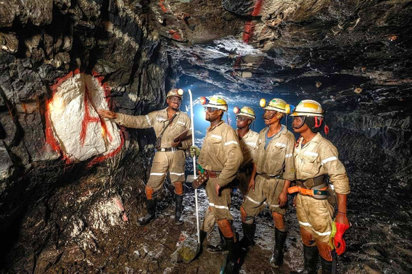
“In those circumstances, a decision was taken, which I think generally was the right decision, to try and open up the economy and make it more competitive,” says Andrew Feinstein, a former Member of Parliament from the ANC who resigned in 2001 to protest the government’s refusal to investigate a multibillion-dollar arms deal tainted by allegations of high-level graft within his party.
The government’s biggest mistake at the time, says Feinstein, is that in its efforts to cut public spending to ensure a low fiscal deficit and secure International Monetary Fund loans, it scrapped most of the protections for South Africa’s domestic industries.
To cite one among many examples, the government radically reduced import subsidies and protective measures for South Africa’s textile and clothing industry, which employed more than 300,000 people in 1994. “Today, the same industry employs around 50,000 people. It has simply been unable to compete with cheap imports,” says Feinstein.
Besides grappling with globalization, he argues, the government should have focused on creating relatively unskilled jobs to meet the nation’s “highly unequal social needs” in housing, basic services, education and health. “But instead of doing that,” Feinstein says, “we restricted public spending and focused on making our economy more competitive so that we could export more.”
Ever since the late 19th century, a large part of South Africa’s economy has relied heavily on exports from its vast and lucrative mining of metals, minerals and precious stones. In fact it was in South Africa’s extraction industry that racial separation became “a doctrine of the workplace long before it was legislated for the country as a whole,” in the words of Joseph Paul Martin, former director of the Center for the Study of Human Rights at Columbia University, and the author of a noted 1998 essay on ethnicity and racism in South Africa and the United States.
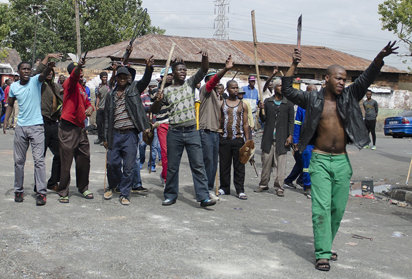
Because there was no skilled local labor in the early years of South African mining, white workers were brought in from Europe, explains Martin. By the beginning of the 20th century, this pool of well-paid immigrants grew large enough to exclude native South Africans from advancement opportunities in other sectors of the economy. Later, partly because of strained racial relations during the apartheid era, South Africa never quite achieved the “industrial diversity and size necessary to sustain well more than a minority of its population,” according to Martin.
That racial legacy continues to play an important role in defining a range of political and economic inequalities in today’s South Africa. The most glaring of these disparities is the fact that while native South Africans almost exclusively control national politics, white South Africans continue to run a huge chunk of the country’s commerce.
Economists have long pointed out that, for its part, the South African government is always eager to determine where and how to use the capital that the nation’s businesses generate. Yet “the primary focus of state interventions has not been to direct the growth path in developmental directions, such as through the development of new industries, but to regulate business in ways that ensure rapid benefits for the new political elite and their allies,” according to Jeremy Seekings, director of the Centre for Social Science Research and a professor of political studies and sociology at the University of Cape Town.
In a 2014 study titled “South Africa: Democracy, Poverty and Inclusive Growth Since 1994,” Seekings found that although the poor among South Africa’s blacks have benefited from the government’s highly aggressive redistribution and spending policies, such as social grants, subsidized healthcare and housing, they have mostly been left out of the larger struggle for employment and wages, which revolves around powerful labor unions that enjoy strong ties to the ruling ANC.
Meanwhile, the white population has reaped greater economic benefits than the black population. Since the end of apartheid, the proportion of whites with skilled jobs has risen from 42 to 61 percent, while the proportion of blacks during the same period has gone up only 12 to 18 percent, according to one estimate.
Not surprisingly, many whites have been able to use their superior state-subsidized education—which was segregated along racial lines during apartheid—to take better advantage of investment opportunities as South Africa opened up its post-apartheid economy, says Elke Zuern, a professor of politics at Sarah Lawrence College and the author of a 2011 book titled The Politics of Necessity: Community Organizing and Democracy in South Africa.
At the same time, because the government’s redistribution policies since independence have been focused on blacks, many white South Africans have gotten poorer. “It’s shocking to many people to see poor whites begging on the streets of South African cities and towns,” says Zuern.
There’s a cruel irony in the government’s failure to shake off apartheid-era systems of redistribution: Because the policies were partly a form of patronage for whites, they were never intended to reduce unemployment or poverty in the black population, which makes up 79.2 percent of South Africans.
Besides, as many analysts of South Africa’s economy agree, redistribution does little or nothing to improve the economy or create jobs because it encourages the poor to consume rather than invest in their future. As a result, redistribution actually perpetuates unemployment.
The conundrum is suitably highlighted by South Africa’s gross domestic product in the first 15 years of independence (through 2009). Although the nation’s economy grew slowly but steadily at an average rate of 3.2 percent annually, according to OECD and World Bank figures, the growth created few if any jobs and largely benefited the black middle and upper classes.
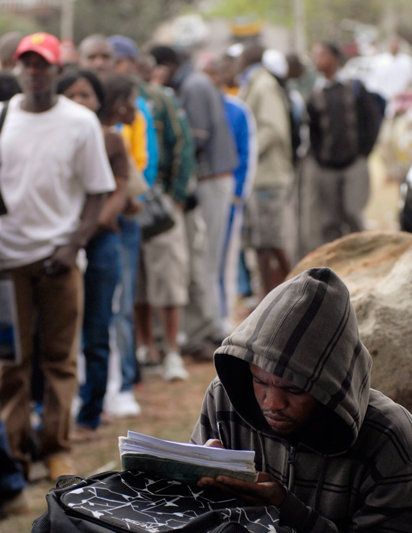
In fact, a tiny group of politically connected native South Africans have become fabulously wealthy through Broad-Based Black Economic Empowerment, a racially selective program that the government launched to correct the inequalities of apartheid. Although on paper any native South African could take advantage of the program, in reality only those with ties to the government tend to get ahead.
That unemployment has increasingly been a driver of socioeconomic inequality in South Africa, especially among the black population, is almost beyond dispute. Nor is it contentious to claim that “the government’s own policies have exacerbated the problem,” says Jeffrey Herbst, president of Colgate University and an expert on the political economy of South Africa.
A big part of the reason why the government’s economic policies are flawed, argues Herbst, is because workers get relatively high wages in a mostly low-skilled business environment that happens to be highly unionized. That, incidentally, also explains why labor regulations discourage employers from hiring new workers, adds Herbst.
In fact, labor unions, formed during the 1980s, have proved to be something of an albatross around South Africa’s neck. During apartheid, explains Herbst, unions were the only legal form of opposition. Because ANC leaders such as Mandela were imprisoned or exiled by the apartheid regime, native South Africans rallied around unions, which functioned as a political network that helped bring the ANC to power in 1994.
“That’s been the basis of the alliance between unions and the ANC ever since,” says Herbst, adding: “It’s fraying now because the ANC’s interests and the unions’ interests are diverging” as South Africa’s economy becomes increasingly globalized.
The ANC also appears to be a victim of its own political success. Like its apartheid-era predecessors, the party has not been challenged by the vast inequities in South Africa’s income distribution—despite the deadly violence it generates from time to time—because the ANC has no viable political competitor, says Herbst.
Although a small minority of South Africans does vote for opposition parties, an increasing number of people over the past 10-12 years “simply don’t vote” in elections, says Herbst. “There’s a perception the ANC hasn’t delivered on its promises and that corruption is a problem.”
UNEMPLOYMENT has increasingly been a driver of socioeconomic inequality in South Africa, especially among the black population.
South Africa was rocked recently by allegations that the government paid $10 million in bribes to officials of the Fédération Internationale de Football Association, the world soccer governing body, to host the 2010 World Cup. Over the years, the ANC-led administration has been dogged by a variety of corruption scandals. In 2013, to cite one example, South Africa’s auditor-general revealed that nearly $50 million in state tenders were awarded to suppliers linked to families or employees of government departments that had invited the public bids.
Besides being South Africa’s dominant challenge, unemployment is also a major threat to the ANC’s electoral fortunes, Herbst says. That, in fact, is the thesis of a book co-authored by Herbst and scheduled to be published in South Africa this summer. How South Africa Works and Must Do Better analyzes why the country isn’t producing enough jobs and what it needs to do to more fully embrace the global economic ties severed during apartheid.
Perhaps the greatest danger of South Africa’s economic underperformance is the likelihood that an entire generation of post-apartheid youth faces not just the prospect of widespread unemployment but also cognitive and political drift.
That grim outlook was the subject of a report released this past April in Johannesburg, South Africa’s biggest city that houses Soweto, where the recent anti-immigrant violence began. Titled “Born Free But Still in Chains,” the report by the South African Institute of Race Relations (IRR), a nonprofit civil rights group, pointed to the gloomy future that awaits as many as 27 million South Africans—exactly half the nation’s population—born in or after 1990.
An increase in AVERAGE YEARS OF SCHOOLING is a key driver of reduced poverty and inequality.
Alluding to the government’s National Development Plan (NDP), the report suggests that youths who fail to find a job by the age of 24 are “unlikely ever to get formal employment.” Further, the 34-page report echoes the NDP’s warning that “expanding opportunities for higher education without a concomitant increase in employment opportunities can be hazardous.”
Although many youth aged 15-24 years are running 74,000 small businesses across the nation, according to the report, the rates of unemployment in this so-called “born-free” demographic are staggering: 67 percent for males and 75 percent for females. “The great majority of born-frees emerge from the country’s education system without the skills that the economy requires,” it notes. The IRR predicts that these youths “will increasingly become more involved in violent protests and abandon democratic institutions due to ongoing political and economic alienation.”
Andrew Ihsaan Gasnolar, a 29-year-old South African of “colored” heritage (neither black nor white), agrees with the report’s assessment. Although Gasnolar missed being in the born-free demographic by five years, he’s familiar with the struggles of contemporary youth.
Gasnolar grew up in Cape Town, South Africa’s second-most populous city and the seat of its Parliament. Until he was old enough to go to college, Gasnolar wasn’t permitted by his single mother, a schoolteacher, to venture alone outside his family’s cramped, two-bedroom house in a forbidding, crime-ridden section of the city.
That’s because Gasnolar was just four years old when his father was run over in the neighborhood by a car while he was trying to flee from a gang of muggers. At the age of 10, a year after apartheid ended, Gasnolar saw a family friend bleed to death from stab wounds sustained in a gang attack.
Despite those early setbacks, Gasnolar went on to become a law adviser to the government of Western Cape province. It’s the kind of career that will likely elude the vast majority of South Africa’s born-free youth.
“We have allowed a broken society to take root in South Africa,” Gasnolar lamented in a recent op-ed article in the Daily Maverick, a popular national newspaper. This year’s anti-immigrant violence, he wrote, has all the signs that South Africans need “to understand that we are really a nation in crisis.”
